Flowers have been used for millennia to express feelings, intentions, and thoughts. Japan has elevated this art form with their own floral language, known as Hanakotoba. Anyone may express themselves via the meticulous arrangement of flowers thanks to this age-old custom, which gives special meanings to certain flowers. In this ultimate guide to Hanakotoba, we’ll explore the history of this art form, its significance in Japanese culture, and the meanings behind some of the most popular flowers used in Hanakotoba.
| Flower Name | Blooming Season | Color | Symbolize |
|---|---|---|---|
| Plum blossom (Ume) | Spring | Pink | Happiness and Hope |
| Camellia (Tsubaki) | Winter to Early spring | Pink and Red | Beauty and love |
| Sakura (Japanese Cherry) | Spring | Pink | Hope and new Life |
| Asagao (Morning Glory) | Summer to Early Fall | Blue | Luck and Prosperity |
| Chrysanthemum (Kiku) | Late summer to early Winter | White and orange | Longevity |
| Red spider lily (Higanbana) | Late summer to early fall | Red | Final goodbyes |
| Sunflower (Himawari) | Spring | yellow | Happiness and Joy |
| Kinmokusei (Orange Osmanthus) | Late summer to fall | Yellowish | Truth and happiness |
| Sasanqua (Camellia Sasanqua) | Late winter to Early spring | Pink | Adoration |
| Iris Flower (Kakitsubata) | Spring to summer | Blue | Peace and Love |
| Sweet pea (Suitopi) | Spring | Red and white | beauty and love |
| Wisteria (Fuji) | Spring | Blue | Beauty |
| Lacecap Hydrangea (Gakuajisai) | Spring | Red and Orange | Love |
| Sakurasou (Primula sieboldii) | Spring | Blue | Honor |
| Momo (Peach) | Spring | White and Pink | Friendship and Love |
Plum blossom (Ume)
A vital and cherished flower in Japanese culture is the ume, or Japanese plum blossom. It blooms in opposition to the chilly winter weather and is regarded as the first flower of spring. The gentle pink color of the blooms represents virtue and purity, while the perfume of the flower denotes the arrival of spring. Ume is a well-liked flower in traditional Japanese poetry and art because it also serves as a symbol of age and beauty in Japanese culture.

Camellia (Tsubaki)
One of the most alluring flowers in Japanese culture is the tsubaki, often known as the camellia blossom. In Japanese tradition, this flower represents perfection and unwavering love. It has a lovely and elegant aspect and is often linked to feminine beauty and the samurai spirit. The camellia bloom also symbolizes the arrival of spring, enduring good fortune, and happy feelings.
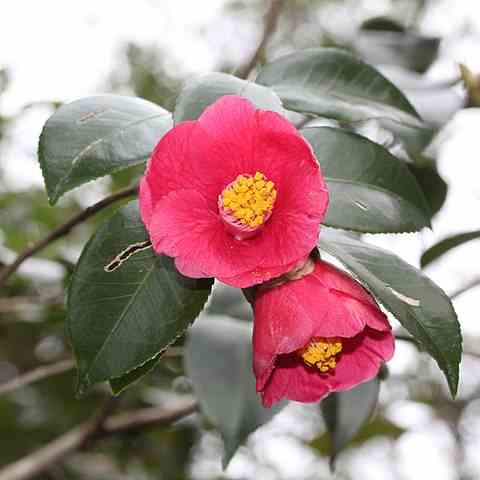
Sakura (Japanese Cherry)
One of Japan’s most well-known flowers is the Sakura, or Japanese cherry blossom. In Japanese culture, these tiny pink blooms stand for transience and the transient essence of beauty. In Japan, cherry blossoms are a well recognized flower, and in the spring, people go to parks to take in their breathtaking display. Among the flowering trees, Japanese people often host gatherings for cherry blossom viewing and food and drink.
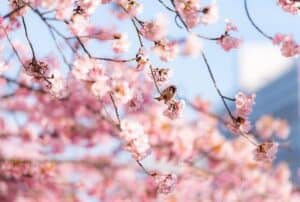
Asagao (Morning Glory)
The morning glory, also known as asagao, is a symbol of love, adoration, and transcendence. This lovely blossom, which is available in pink, purple, blue, and white hues, symbolizes several types of love in Japanese culture. The morning glory flower is also connected to the Buddhist idea of transcending the physical realm and achieving spiritual enlightenment.
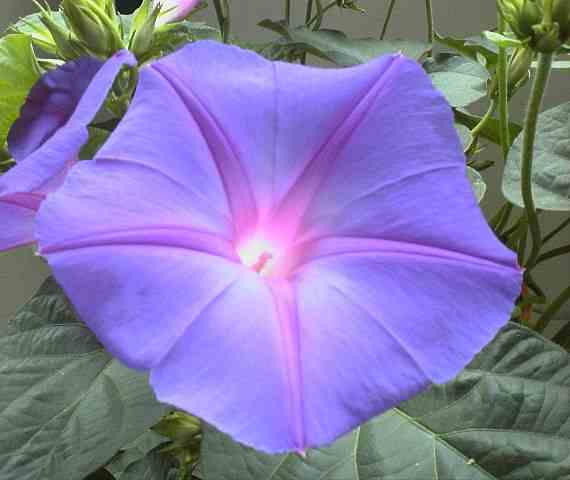
Chrysanthemum (Kiku)
The chrysanthemum, or kiku, is the official symbol of Japan’s royal dynasty and stands for perfection, nobility, and longevity. It is a versatile flower, and each of its many hues and variants has a unique symbolic significance. The chrysanthemum flower is also utilized in traditional Japanese tea rituals, and it is often depicted in Japanese ceramics, textiles, and art.

Red spider lily (Higanbana)
In Japanese culture, the Higanbana, also known as the red spider lily, represents death and the transient aspect of life. At the time of the autumnal equinox, when Japanese families customarily pay homage to their ancestors’ graves, this stunning flower blossoms. It is a traditional burial flower in Japan and is grown close to the boundaries of cemeteries. It is sometimes referred to as “hell flowers” and “cluster amaryllis.”
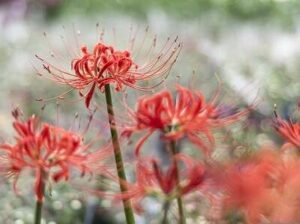
Sunflower (Himawari)
The sunflower, or himawari, represents cheerfulness, affection, and loyalty. The sun-like look of this flower represents joy and the warmth and vitality of the sun. The sunflower is a symbol of fresh beginnings or admiration in Japanese culture.

Kinmokusei (Orange Osmanthus)
Kinmokusei, also known as an orange osmanthus, symbolizes passion, sensuality, and love in Japanese culture. It is a captivating flower with a lovely aroma that represents the love shared by two individuals.
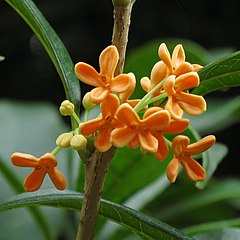
Sasanqua (Camellia Sasanqua)
Sasanqua, also known as the Camellia sasanqua, is an evergreen blooming shrub that in Japanese culture symbolizes chastity, humility, and devotion. In Japan, the blooming of this flower heralds the beginning of fall with its fragrant and delicate blooms.
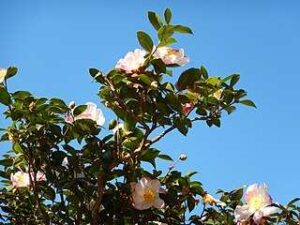
Iris Flower (Kakitsubata)
In Japanese culture, the iris flower, or kakitsubata, symbolizes adoration, bravery, and optimism. It is a versatile flower that comes in a variety of hues, and its beauty never fails to catch people’s eyes. In addition, the iris flower plays a key role in Japanese mythology and is often portrayed in literature and art, demonstrating the flower’s historical and cultural significance.
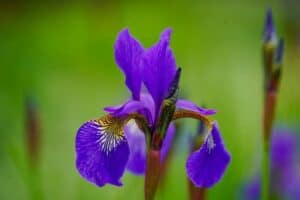
Sweet pea (Suitopi)
Suitopi, or the sweet pea, represents thanks, appreciation, and satisfaction in Japanese culture. It is a little, fragrant flower that may be found in a variety of hues, including as blue, purple, pink, and white. Sweet peas are also connected to luck and a nice vibe.

Wisteria (Fuji)
In Japanese culture, Fuji, or wisteria, is a lovely climbing plant that symbolizes grandeur, passion, and eternal beauty. This flower is prized for its cascading blossoms that hang from the ceiling, which represents the beauty and elegance of the samurai’s character.
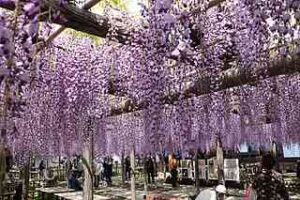
Lacecap Hydrangea (Gakuajisai)
In Japanese culture, the lacecap hydrangea, also known as gakuajisai, is a gorgeous flower that represents sincere feelings, peace, and regret. In Japan, hydrangeas are a symbol of graciousness and delicate beauty.

Sakurasou (Primula sieboldii)
In Japanese culture, the Sakurasou, or Primula sieboldii, represents the beauty of youth, humility, and love. Its lovely look is delicate and compassionate, and its light pink and lavender tones stand for unadulterated, unadulterated love.
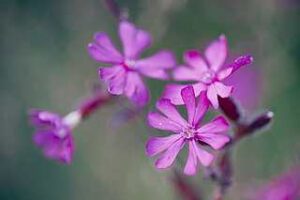
Momo (Peach)
Momo, also known as the peach blossom, is a well-known flower in Japanese culture that represents beauty, longevity, and immortality. The peach blossom is a favorite among Japanese people and is often used in traditional Japanese art and textiles due to its lovely look and delicious aroma.
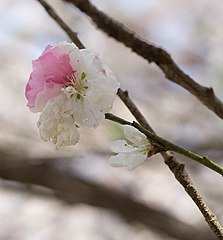
How to Use Hanakotoba in Modern Times
Hanakotoba may have its origins in traditional Japanese culture, but it may still be utilized today to subtly and elegantly communicate feelings and intents. Understanding the significance of various flowers will help you design a more meaningful and thoughtful arrangement, whether you’re making a floral arrangement for a particular event or just to add some beauty to your house.
FAQs
How can Hanakotoba be used in modern times?
Hanakotoba may still be utilized today to subtly and elegantly communicate feelings and intentions. Understanding the significance of various flowers will help you design a more meaningful and thoughtful arrangement, whether you’re making a floral arrangement for a particular event or just to add some beauty to your house.
What is the significance of flowers in Japanese culture?
In Japanese culture, flowers have traditionally had a particular position and are often utilized to express feelings and intentions. Hanakotoba, which enables people to communicate via the language of flowers, is an expression of its cultural importance.
What does Sakura mean in Hanakotoba?
Sakura symbolizes a pure and kind heart in Hanakotoba. The Sakura’s delicate pink and white blooms stand for simplicity, innocence, and purity. These blooms are also a symbol of rebirth and the arrival of spring. Peace, calm, and purity are conjured up by their gentle beauty and smell.
Sakura have been utilized for a variety of purposes in Japanese culture, including cosmetics and as a flavoring or adornment for food, particularly sweets. The blossoming of Sakura trees is a greatly awaited occasion in Japan, and the nation hosts several Sakura celebrations to mark the start of spring.
What does Tsubaki Hanakotoba mean?
Tsubaki’s symbol of prudence denotes modesty and humility. The flower also represents a sensation of longing, which may be understood as a desire for something or someone. The symbol of perfect love used by Tsubaki denotes a sincere and loyal attachment that is often connected to romantic love.
Due to its long history of cultivation and appreciation, tsubaki occupies a particular position in Japanese culture. In Japan, Tsubaki is often connected with the tea ceremony, and flowers are used to adorn the tea room. Since it is thought to have advantageous effects for the skin, tsubaki is also utilized in a variety of cosmetics and beauty products in Japan.
Tsubaki blossoms are often used in Japanese art and literature due to their aesthetic appeal and symbolism. The plant is often mentioned in Japanese poetry, paintings, and other forms of creative expression as being associated with prudence, desire, and ideal love.
What does Daisy mean in Hanakotoba?
Daisy, a delicate flower, is appreciated by individuals who are innocent and pure of heart, and has the meanings of “beauty,” “peace,” and “hope” in Hanakotoba, the Japanese language of flowers. Daisies are often used in flower arrangements and bouquets to express emotions like pleasure, friendliness, and happiness. The name of the flower is often gilded on the hanko, a traditional Japanese seal, as a symbol of luck and wealth.
The “he loves me, he doesn’t” game, which is often performed by removing the petals from a daisy, may be related to the fact that daisies are frequently connected in English with hidden or enigmatic love. Nonetheless, daisies are a common option for bridal bouquets and presents in Hanakotoba since they stand for loyalty and devotion.
There are several sorts of daisies, and each one could symbolize something somewhat different. White daisies, for instance, are a symbol of innocence and purity, while yellow daisies are a symbol of joy and brightness. Red daisies are a symbol of love and passion, while pink daisies are connected to romance and adoration.
What does lotus mean Hanakotoba?
The lotus flower ( / Hasu) has a very deep connotation of purity, enlightenment, and spiritual awakening in Hanakotoba, the language of flowers in Japan. The lotus is valued in Japanese culture for its aesthetic appeal, sweet aroma, and significance. The lotus flower, which represents enlightenment that emerges from the hardship and turbulence of life, blooms from the murky, muddy water and emerges as a breathtakingly beautiful white blossom. This is why the lotus flower is often linked to enlightenment and spiritual development.
The lotus flower is admired for its graceful appearance in addition to its meaning. The lotus features big, luxuriant petals that are often pink or white and a characteristic circular form with a central pistil. It is often employed in Ikebana, the technique of arranging Japanese flowers, as well as traditional Japanese art forms including paintings and pottery.
Lotus flowers may be used to floral arrangements in Hanakotoba to signify love, chastity, or purity. You may express a feeling of cleanliness of the body, speech, and mind as well as a profound spiritual meaning by including the lotus flower into your arrangements. The lotus blossom is a lovely and symbolic flower that has been highly esteemed in Japanese culture for ages, making it an ideal accent to any floral arrangement.
What does daffodil mean in hanakotoba?
Daffodils are a symbol of respect in Hanakotoba, the Japanese language of flowers. Since it is one among the earliest flowers to emerge in the spring and because of its vivid yellow hue, this flower is often connected to the season. The daffodil is a symbol of optimism and rejuvenation because to its vivid color and early bloom.
The daffodil is the ideal embodiment of the respect that is highly valued in Japanese society. The daffodil is often used in arrangements in Japanese flower arranging, or Ikebana, to show affection or gratitude for someone. A person’s day might be made better and they can feel loved by this flower’s exquisite look and cheery hue.
Daffodils are a symbol of respect as well as unrequited love. This interpretation comes from the Greek tale of Narcissus, who fell in love with his own reflection in a pool of water and was turned into a flower. Because of their connection to this tale, daffodils are a common flower to send to a distant admirer.
What does hydrangea mean in Hanakotoba?
Beautiful flowers called hydrangeas, or “ajisai” in Japanese, are widely beloved in Japan, especially during the rainy season. Nonetheless, depending on their hue and cultural setting, they have many symbolic connotations. Hydrangeas are connected to pride in Hanakotoba, the Japanese language of flowers. Hydrangeas have been prized in Japan since the Nara Period, and writings from that time period often mention them. This is according to Japan Avenue. Moreover, they have been included into tea rituals and Japanese gardens as ornamental accents.
White hydrangeas are a symbol of boasting or bragging, whereas blue hydrangeas are a symbol of frigidity and remorse. Purple hydrangeas, on the other hand, symbolize for a desire to fully comprehend someone, while pink hydrangeas stand for true sentiments, love, and thanks. The cultural meaning and symbolism of hydrangeas varies among countries, and some interpretations may be different from Hanakotoba.
Touko and Sayaka trade white and blue hydrangeas in the anime series Bloom Into You, respectively, to represent the meanings of the flowers in Hanakotoba. The blue hydrangea might represent an apology, whilst the white hydrangea can represent boastfulness. The characters’ inner sentiments for one another are expressed via the exchange of these flowers, which reflects the depth and complexity of their connection.
What does Cosmos mean hanakotoba?
Each flower has a unique significance in Hanakotoba, the Japanese language of flowers. Cosmos, or Kosumosu in Japanese, is a common flower in Japan that symbolizes humility, peace, and purity. Those with pure hearts adore it as their favorite flower. Each hue of Cosmos has an own particular significance.
For instance, the color white is a symbol of elegance, loyalty, and dedication. Since it represents the bride’s loyalty to the husband, it is the perfect flower for weddings. On the other hand, red cosmos denotes devotion and love. Pink represents purity.
Japan’s culture has always included cosmology. One of the greatest sites in Japan to observe cosmos flowers in bloom is at Showa Memorial Park. Cosmos has also found a home in Japanese literature, films, and animation, where it is often utilized to communicate ideals of love and purity.
In addition to Hanakotoba, the cosmos has also been important in Japanese gardening. Cosmos are often used in the designs of Japanese gardeners to bring a touch of class and beauty to the environment.
What does lily of the valley mean in Hanakotoba?
Lily of the Valley is a symbol of sweetness in Hanakotoba, the Japanese language of flowers, and is preferred by individuals who are chaste and humble. The flower represents a promise of pleasure and a return to an upbeat frame of mind. The hanko’s elegance and beauty are enhanced by the gilding of the flower’s name.
Lily of the Valley is deeply ingrained in Japanese culture and is often connected to the arrival of spring. The small bell-shaped blossoms, which are a visual indicator of the start of spring, are grown in northern Japan. It is crucial to remember that while the Lily of the Valley is not native to Japan, it is often planted in gardens all throughout the island nation.
Spiritual and religious concepts are firmly ingrained in Lily of the Valley’s symbol meanings. It is said to stand for virtue, humility, and motherhood. The flower is intimately identified with the Virgin Mary, and its stunning, teardrop-shaped flowers are a symbol of the divine feminine.
Lily of the Valley is revered for its spiritual importance as well as for being a symbol of success and fortune. It is a favorite flower for bridal bouquets and other special events, and it is often presented as a gift to commemorate the start of spring.
Conclusion
Hanakotoba is a lovely and historic art form that enables us to communicate with one another through the language of flowers. We may make more meaningful and considerate arrangements that subtly and elegantly express our feelings and intentions by studying the meanings associated with certain flowers.
Black Lotus Flower Meaning – Symbolism, Tattoo, Spiritual Definition
Peony Flower Meaning And Symbolism – Know Everything
